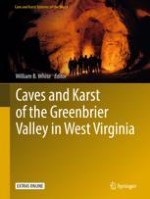2018 | OriginalPaper | Chapter
18. Terrestrial Fauna in the Greenbrier Karst
Authors : David C. Culver, Daniel W. Fong
Published in: Caves and Karst of the Greenbrier Valley in West Virginia
Publisher: Springer International Publishing
Activate our intelligent search to find suitable subject content or patents.
Select sections of text to find matching patents with Artificial Intelligence. powered by
Select sections of text to find additional relevant content using AI-assisted search. powered by
